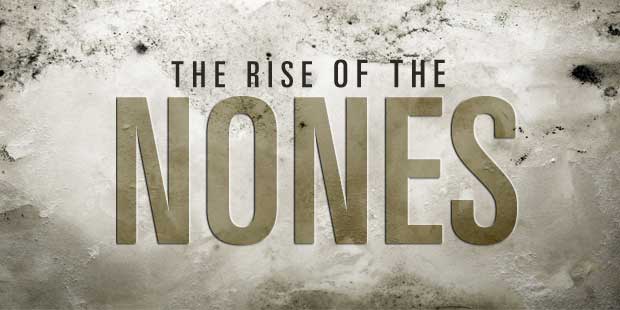
Religious “nones” – a shorthand we use to refer to people who self-identify as atheists or agnostics, as well as those who say their religion is “nothing in particular” – now make up roughly 23% of the U.S. adult population. This is a stark increase from 2007, the last time a similar Pew Research study was conducted, when 16% of Americans were “nones.” (During this same time period, Christians have fallen from 78% to 71%.)
Overall, religiously unaffiliated people are more concentrated among young adults than other age groups – 35% of Millennials (those born 1981-1996) are “nones.” In addition, the unaffiliated as a whole are getting even younger. The median age of unaffiliated adults is now 36, down from 38 in 2007 and significantly younger than the overall median age of U.S. adults in 2014 (46).
Overall, religiously unaffiliated people are more concentrated among young adults than other age groups – 35% of Millennials (those born 1981-1996) are “nones.” In addition, the unaffiliated as a whole are getting even younger. The median age of unaffiliated adults is now 36, down from 38 in 2007 and significantly younger than the overall median age of U.S. adults in 2014 (46).
We are perhaps all familiar with this statistic and know that this is an on-going trend.
However, there is a far more interesting question than simply measuring what is going on. This all quite naturally less us to wonder why it is like this, what has changed?
A New Pew Poll Asks Why?
Pew, also thought that this was an interesting question and so they asked. To be more precise, they polled those who identified as “nones” …
we asked these people to explain, in their own words, why they no longer identify with a religious group
… and so the results of this are now available.
As a quick bit of background, it was actually part of a broader survey designed to explore the religious landscape in more detail. They were primevally looking into why people choose a new church, what motivates them to start looking, and opt for one over another. However, since nones were clearly opting to select no church, they also asked them about that. If looking for the Nones bit, you will find it all buried within page 29 of the full report. (The complete pdf report runs to 44 pages – link at bottom of article).
They broke it down into three categories of “Nones” who use different labels to describe themselves – “Atheists”, “Agnostics”, and “Nothing in Particular”. Then for each of those streams they divide up the percentages of answers received into these main categories …
- Don’t believe
- Dislike organised religion
- Unsure/undecided
- Inactive
- Other
- Unclear
The results were as follows …
The answers revealed by their survey are exactly what you might expect. For example, the most common reason for people, who do believe and attend, to select a new Church was … (insert drum roll here) … they had moved … (gasp, what a surprise). From the above it is also clear that the primary reason why the nones had opted out is because, (once again, not exactly a huge surprise), they no longer believe.
Beyond the Raw statistics
People did give specific reasons and so beyond simply ticking a box, they wrote an explanation down. Here are some examples of the actual responses given …
Summary
While this does probe a bit deeper, and does also reveal that the oft quoted Christian assertion that all those who use such labels do really secretly believe is indeed not factual, it does not actually answer the question – “Why?”.
Clearly we have peeled back one more layer, but the question still remains in place and this does not give us any deep insights.
I do have my own thoughts and will briefly outline my thinking. What is clear is that something dramatic has happened to inspire such a demographic change. One huge event that is proving itself to be highly disruptive has been the arrival of a greatly increased flow of information. Many of us now carry within our pockets smartphones that give us more or less instant access to the entirety of human knowledge, and so things we hear or read can be rapidly fact-checked. We are also exposing ourselves to a constant stream of new information that can successfully punch through the barriers that previously prevailed. We find amongst our on-line peers a community that does not embrace the traditional thinking, but is instead open to better ideas. It is amongst the young, those that are most active on-line that we observe the greatest degree of change.
We have been here before as a species. When the printing press arrived, it created a new flow of information that eventually gave birth to an age of enlightenment, and right now something akin to that is once again taking place.
There are huge challenges. Much of the information that flows is perhaps best tagged “myth-information”, and so we need to learn how to sift and glean the things that are meaningful and true from out of the cacophony of noise. In some respects the US election in November is a test that will determine just how well that is going.
What is inevitable is that this new demography will continue to grow, learn new things and be inspired by newer better ideas, nothing has emerged to change that.
Oh, and one other passing observation. Looking over at the Choosing a New Church or House of Worship survey, I note with interest that almost half (49%) of those that do believe only actually attend rarely, and 22% of them confirmed that they used to attend a lot more.
Links
Here are the related details.